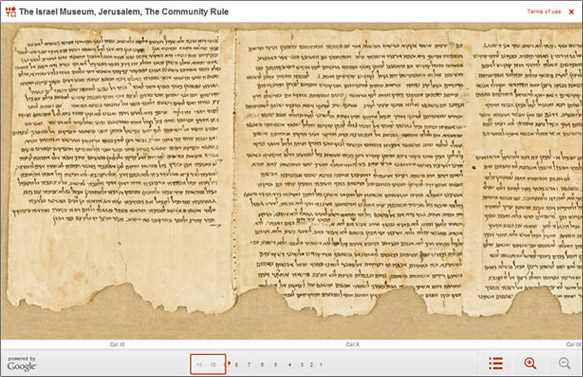The Community Rule
The Community Rule (Serekh Hayahad, 1QS), formerly called the "Manual of Discipline," is the major section of one of the first seven scrolls discovered in Cave 1 at Qumran in 1947. Written in Hebrew in a square Hasmonean script, it was copied between 100 and 75 BCE.
In addition to this manuscript, fragments of no less than ten additional copies of the work were found in Cave 4 (4Q255-264), and two tiny fragments of another copy came to light in Cave 5 (5Q11). The copy from Cave 1 is the best preserved and contains the longest version of the text known to us. On the basis of comparison with the fragments from Cave 4, however, scholars have concluded that the manuscript from Cave 1 represents a late stage in the evolution of the composition.
The Community Rule is a sectarian work, crucial for understanding the Community's way of life. It deals with such subjects as the admission of new members, conduct at communal meals, and even theological doctrines (such as the belief in cosmic dualism and in predestination). The picture that emerges from the scroll is one of a communal, ascetic life governed by rigorous rules, which transformed the members of the Community into "priests in spirit," who lived sacred lives in a "spiritual temple." The Community members patterned their daily lives in symbolic imitation of the lives of the priests serving in the Temple by praying and performing ritual ablutions, thereby acting in blatant opposition to the "defiled" physical Temple in Jerusalem.
At this time, rule literature was a new genre, which would later become part of the Christian monastic tradition (for example, the sixth-century Rule of Saint Benedict). The discovery of the Community Rule at Qumran is the earliest evidence for the existence of the genre in Western civilization. The importance of this work lies in the fact that it provides a rare opportunity to learn about the lives of the sectarians, whom we assume to be Essenes, through their own rule literature. Prior to the discovery of the scrolls, little was known about the Essenes apart from the evidence of classical sources (Flavius Josephus, Philo, and Pliny the Elder), as well as a few hints in rabbinic literature.
